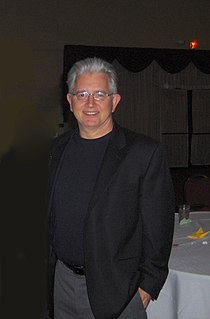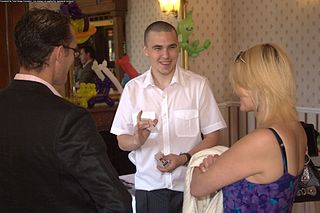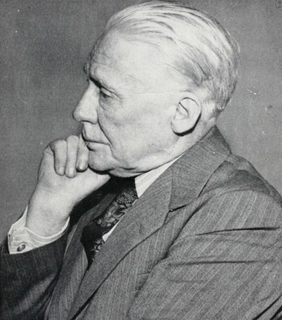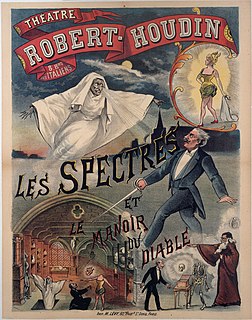
Jean-Eugène Robert-Houdin was a French watchmaker, magician and illusionist, widely recognized as the father of the modern style of conjuring. He transformed magic from a pastime for the lower classes, seen at fairs, to an entertainment for the wealthy, which he offered in a theatre opened in Paris, a legacy preserved by the tradition of modern magicians performing in tails.

The cups and balls is a performance of magic with innumerable adaptations. Street gambling variations performed by conmen were known as Bunco Booths. A typical cups and balls routine includes many of the most fundamental effects of magic: the balls can vanish, appear, transpose, reappear and transform. Basic skills, such as misdirection, manual dexterity, sleight of hand, and audience management are also essential to most cups and balls routines. As a result, mastery of the cups and balls is considered by many as the litmus test of a magician's skill with gimmick style tricks. Magician John Mulholland wrote that Harry Houdini had expressed the opinion that no one could be considered an accomplished magician until he had mastered the cups and balls. Professor Hoffman called the cups and balls "the groundwork of all legerdemain".

Mentalism is a performing art in which its practitioners, known as mentalists, appear to demonstrate highly developed mental or intuitive abilities. Performances may appear to include hypnosis, telepathy, clairvoyance, divination, precognition, psychokinesis, mediumship, mind control, memory feats, deduction, and rapid mathematics. Mentalists perform a theatrical act that includes effects that may appear to employ psychic or supernatural forces but that are actually achieved by "ordinary conjuring means", natural human abilities, and an in-depth understanding of key principles from human psychology or other behavioral sciences.

Max Maven is an American magician and mentalist whose performances are considered erudite and intelligent. He is ranked as one of the most influential mentalists of all time, and one of the 100 "Most Influential Magicians of the 20th Century" by Magic Magazine.

Dai Vernon, a.k.a. The Professor, was a Canadian magician. His sleight of hand technique and knowledge, particularly with card tricks and close-up magic, garnered him respect among fellow magicians, and he was a mentor to other magicians. He lived out his last years at Magic Castle, a nightclub in Hollywood, California.

Street magic falls into two genres; traditional street performance and guerrilla magic.

Paul Gertner is an American close-up magician from Pittsburgh. He is best known in the magic world for his Steel and Silver book and set of DVDs.

Whit "Pop" Haydn is an American magician, and the winner of seven performing awards from the Academy of Magical Arts. He has been nominated by his fellow members for "Magician of the Year" in Close-Up, Parlor and Stage, Bar and Lecturer more than thirty times. In February 2006, he also became Vice-President of that organization, and served for four years in that capacity.
Midwest Magic Jubilee is an annual magic convention held in Missouri.

Close-up magic is magic performed in an intimate setting usually no more than 3 meters from one's audience and is usually performed while sitting at a table.

The Tarbell Course in Magic is a notable encyclopedia of magic amongst professional and amateur magicians. It has eight volumes; the first five were part of the original home-study correspondence course compiled in 1928 by Dr. Harlan Tarbell, the remaining three volumes being added on later.

Jean Hugard was an Australian professional magician.
The Bamberg Magical Dynasty were a Dutch family of magicians. Six generations of Dutch magicians were named Bamberg. The Bambergs were an upper middle-class unorthodox Jewish family. The oldest sons were also magicians and carried on the tradition. This tradition was not always exclusive to just the oldest son; Theo Bamberg's two younger brothers were also magicians. Three Bambergs were court magicians entertaining the royal family. This chain was unbroken for 165 years, from the 18th to the 20th centuries.

Magic, which encompasses the subgenres of illusion, stage magic, and close up magic, among others, is a performing art in which audiences are entertained by tricks, effects, or illusions of seemingly impossible feats, using natural means. It is to be distinguished from paranormal magic which are effects claimed to be created through supernatural means. It is one of the oldest performing arts in the world.

Magicana is a Canadian federally incorporated not-for-profit arts organization dedicated to the study, exploration and advancement of magic as a performing art. Magicana is governed by a volunteer Board of Directors. Julie Eng serves as Magicana's Executive Director and David Ben as its Artistic Director.

The aerial suspension, ethereal suspension or broomstick illusion is an illusion in which the performer appears to be suspended in mid-air for some minutes, with either inadequate support or no apparent support of his or her weight. This trick was first recorded in India and Europe in the early 19th century.

Liang-Shun Lim, known professionally as Shin Lim, is a Canadian-American magician, recognized for his use of card manipulation and sleight of hand. He is known for elaborate close-up card magic routines, during which he remains silent with the tricks set to music. He is self-taught, having learned most of his skills from watching YouTube, on which he has since shared some of his techniques.

The Théâtre Robert-Houdin, initially advertised as the Théâtre des Soirées Fantastiques de Robert-Houdin, was a Paris theatre dedicated primarily to the performance of stage illusions. Founded by the famous magician Jean-Eugène Robert-Houdin in 1845 at No. 164 Galerie Valois as part of the Palais-Royal, it moved in 1852 to a permanent home at No. 8, Boulevard des Italiens. The theatre's later directors, before its demolition in 1924, included Robert-Houdin's protégé Hamilton and the illusionist and film innovator Georges Méliès.















